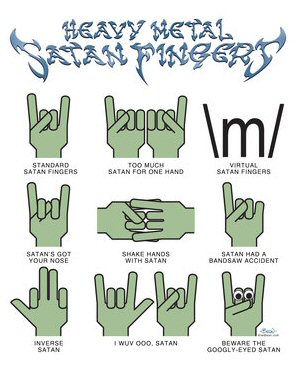
A little known fact (to me, anyway…and it may not be a fact at all) about signs of the horns (aka “Devil’s Horns” aka “the Goat” aka “Satan Fingers”):
Though not necessarily the first to ever use [horned hand gestures] in a “rock” setting, [heavy metal singer Ronnie James] Dio was without question the one who turned it into a popular symbol. So while legions of rock fans test their metal (as it were), they are also unconsciously forming an enormous protective shield against the power of the evil eye. The next time you feel the uncomfortable gaze of a stranger and fear the wrath of the evil eye, perhaps the safest place to go is your nearest heavy metal venue.
— from “The Eyes Have It” — an interesting cultural history of the Evil Eye at the Wunderkammer at Curious Expeditions: Traveling and Exhuming the Extraordinary Past.
In his essay on “The Uncanny,” Freud describes the “source of the dread of the evil eye” as a sort of sublimated jealousy, rather than a fear of supernatural power:
Whoever possesses something that is at once valuable and fragile is afraid of other people’s envy, in so far as he projects on to them the envy he would have felt in their place. A feeling like this betrays itself by a look even though it is not put into words; and when a man is prominent owing to noticeable, and particularly owing to unattractive, attributes, other people are ready to believe that his envy is rising to a more than usual degree of intensity and that this intensity will convert it into effective action. What is feared is thus a secret intention of doing harm, and certain signs are taken to mean that that intention has the necessary power at its commend.
By comparing a person “who possesses something…valuable and fragile,” Freud seems to level the person who glares with an evil eye to something akin to a dog snarling over its bone when anyone approaches it. Thus, I read Freud’s argument about the evil eye as not merely about the psychology of envy (see Hakim Bey’s musings on this), but a manifest sign of a power conflict, an ideologeme of the political unconscious. That is, the evil eye can be read as an ideological sign that circulates in a political economy: those with fragile (symbolic/economic) power unconsciously wield it over those without such power, out of fear that they’ll lose such power.
So where in contemporary culture do we find the archaic sign of the evil eye? I’m not entirely sure, but I suspect it has become generalized as a cyberoptic, embodied by the camera lens of “big brother” and integrated into the panoptical gaze of a paranoiac culture. I need to think about this more fully, because the evil eye has become so domesticated, its everywhere.
But for now, is it too much to suggest that when metal fans thrash their devil horns along with the rich rock musicians on stage, this is a collective sign of class resistance? I don’t think so. Maybe it’s as patently obvious as a crowd of subjects giving a king the middle finger in a transgressive festival. But the grounding of the “mal occia” heavy metal hand sign in the uncanny folklore of the evil eye makes it a very rich metaphor to consider, in terms of popular culture.
Hello,
this is a very interesting post!.
I invite you to go to this website http://www.LuckyEyesOnline.com to see what we have to ward off the “evil eye”.
Hilarious. Gotta use the nose one sometime. m/